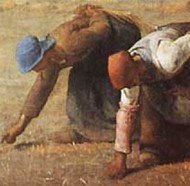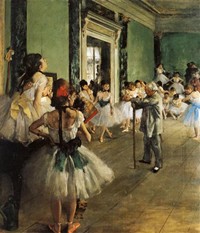|
|
Drawings
The Musee d'Orsay's drawing
collection encompasses artists born after 1820 and before 1870, although
exceptions have been made: for instance, the great Henri Matisse (born
in 1869) is excluded, except for his painting Luxe, Calme et Volupte (1904),
while some artists born before 1820 are included, such as Francois Bonvin,
Gustave Courbet, Charles-Francois Daubigny, Honore Daumier, Henri Harpignies,
Ernest Meissonier and Jean-Francois Millet.
The graphics collection now amounts to
more than ten thousand drawings, including masterpieces like: The Black
bow by Georges Seurat, Portrait of Manet by Edgar Degas, the Self-Portrait
by Gustave Courbet, drawings by Herman-Paul covering the the Dreyfus trial
in Rennes, as well as many other by the greatest draughtsmen of the second
half of the 19th century.
Decorative
Arts
Being devoted to the arts of the second
half of the 19th century, the Musee d'Orsay has been endowed with a program
which aims to celebrate the links between architecture, painting, sculpture
and decorative art, which
emerged from the beginning of the Second Empire. During the work-up to
opening, museum curators succeeded in putting together a decorative arts
collection of some 1,000 items. Sources included: the Musee des Arts Decoratifs,
the Musees-chateaux de Fontainebleau, Compiegne and Malmaison, the Musee
de Cluny, the Louvre etc). This has since been enlarged in several different
directions.
Decorative Art Collection
Highlights include: porcelain from Sevres
and tapestry art from the Beauvais and
Gobelins tapestry
factories, furniture by Roudillon, Fourdinois and Diehl (including a large
medal cabinet decorated with bronzes by Fremiet), wood carvings from the
Gueret brothers, bronze objets d'art by Barye, Crozatier and Barbedienne,
faience and glasswork by Galle, stained glass by Gruber, stoneware by
Carries and Hoentschel, silver by Follot, vases by Otto Eckmann, chairs
by Carlo Bugatti, a cabinet by Gimson, hangings by Voysey, gold work by
Hoffmann, glasswork by Kolo Moser, stained-glass windows by Tiffany, cast
iron ornaments by Guimard and rare white furniture by Charles Rennie Mackintosh.
Other Art Nouveau artists
represented include designers and architects such as: Victor
Horta (1861-1947), Serrurier-Bovy, Carabin, Carot, Alexandre Charpentier,
Coulier, the Daum brothers, Healy, Adolphe Loos, Majorelle, Vallin, Van
de Velde, Otto Wagner, and Frank Lloyd Wright.
Photography
In 1977, when the decision was taken to
convert the Gare d'Orsay railway station into a museum for 19th century
painting, sculpture and drawing, no fine arts museum in France possessed
a photography section. Despite this space was allocated in the Musée
d'Orsay for just such an exhibit. This meant however that the collection
had to be built up from scratch since neither the Musée du Luxembourg,
the Galerie nationale du Jeu de Paume or the Louvre had any fine
art photography.
Cutting a long story short, by the time
the Musée d'Orsay opened, its photographic collection amounted
to some 12,000 photographs - which has since risen (2008) to 45,000. Highlights
include works by Ferdinand Knopff, Jean Laurent, Man Ray, Stieglitz, Le
Secq, Aldolphe Humbert de Molard, Maurice Denis and Roger Fenton.
Contact Details
Musee d'Orsay
1, rue de la Légion d'Honneur, 75007 Paris.
Telephone: 01-40-49-48-14.
Admission: €8.00 adults; €5.50 ages 18-30; free for ages 17
and under.
Opening Hours: Daily, 9.30am-6pm; closed on Mondays.
Website: www.musee-orsay.fr
|

